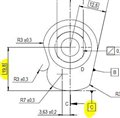And how would i get the right orientation for the dimension
Posting pic of datum and the callout/ boxed dimension
Attached Files


Your Products have been synced, click here to refresh


PLN1 =FEAT/PLANE,CARTESIAN,OUTLINE
THEO/<0.125,-0.375,0>,<0,0,1>
ACTL/<0.125,-0.375,0>,<0,0,1>
MEAS/PLANE,4
HIT/BASIC,NORMAL,<10.5,0,0>,<0,0,1>,<10.5,0,0>,USE THEO=YES
HIT/BASIC,NORMAL,<0,10.5,0>,<0,0,1>,<0,10.5,0>,USE THEO=YES
HIT/BASIC,NORMAL,<-10,3,0>,<0,0,1>,<-10,3,0>,USE THEO=YES
HIT/BASIC,NORMAL,<0,-15,0>,<0,0,1>,<0,-15,0>,USE THEO=YES
ENDMEAS/
A1 =ALIGNMENT/START,RECALL:STARTUP,LIST=YES
ALIGNMENT/LEVEL,ZPLUS,PLN1
ALIGNMENT/TRANS,ZAXIS,PLN1
ALIGNMENT/END
CYL1 =FEAT/CYLINDER,CARTESIAN,OUT,LEAST_SQR
THEO/<0,0,-5>,<0,0,1>,14,10
ACTL/<0,0,-5>,<0,0,1>,14,10
MEAS/CYLINDER,8
HIT/BASIC,NORMAL,<7,0,-10>,<1,0,0>,<7,0,-10>,USE THEO=YES
MOVE/CIRCULAR
HIT/BASIC,NORMAL,<0,7,-10>,<0,1,0>,<0,7,-10>,USE THEO=YES
MOVE/CIRCULAR
HIT/BASIC,NORMAL,<-7,0,-10>,<-1,0,0>,<-7,0,-10>,USE THEO=YES
MOVE/CIRCULAR
HIT/BASIC,NORMAL,<0,-7,-10>,<0,-1,0>,<0,-7,-10>,USE THEO=YES
MOVE/CIRCULAR
HIT/BASIC,NORMAL,<0,-7,0>,<0,-1,0>,<0,-7,0>,USE THEO=YES
MOVE/CIRCULAR
HIT/BASIC,NORMAL,<-7,0,0>,<-1,0,0>,<-7,0,0>,USE THEO=YES
MOVE/CIRCULAR
HIT/BASIC,NORMAL,<0,7,0>,<0,1,0>,<0,7,0>,USE THEO=YES
MOVE/CIRCULAR
HIT/BASIC,NORMAL,<7,0,0>,<1,0,0>,<7,0,0>,USE THEO=YES
ENDMEAS/
A3 =ALIGNMENT/START,RECALL:A1,LIST=YES
ALIGNMENT/TRANS,XAXIS,CYL1
ALIGNMENT/TRANS,YAXIS,CYL1
ALIGNMENT/END
PLN2 =FEAT/PLANE,CARTESIAN,OUTLINE
THEO/<10.78,-8.065,-5>,<0.9659258,-0.258819,0>
ACTL/<10.78,-8.065,-5>,<0.9659258,-0.258819,0>
MEAS/PLANE,4
HIT/BASIC,NORMAL,<12.074,-3.235,-2>,<0.9659258,-0.258819,0>,<12.074,-3.235,-2>,USE THEO=YES
HIT/BASIC,NORMAL,<12.074,-3.235,-8>,<0.9659258,-0.258819,0>,<12.074,-3.235,-8>,USE THEO=YES
HIT/BASIC,NORMAL,<9.486,-12.894,-8>,<0.9659258,-0.258819,0>,<9.486,-12.894,-8>,USE THEO=YES
HIT/BASIC,NORMAL,<9.486,-12.894,-2>,<0.9659258,-0.258819,0>,<9.486,-12.894,-2>,USE THEO=YES
ENDMEAS/
A2 =ALIGNMENT/START,RECALL:A1,LIST=YES
ALIGNMENT/ROTATE,XPLUS,TO,PLN2,ABOUT,ZPLUS
ALIGNMENT/ROTATE_OFFSET,15,ABOUT,ZPLUS
ALIGNMENT/END
SCN1 =BASICSCAN/CIRCLE,NUMBER OF HITS=8,SHOW HITS=NO,SHOWALLPARAMS=NO
ENDSCAN
SCN2 =BASICSCAN/CIRCLE,NUMBER OF HITS=8,SHOW HITS=NO,SHOWALLPARAMS=NO
ENDSCAN
SCN3 =BASICSCAN/CIRCLE,NUMBER OF HITS=8,SHOW HITS=NO,SHOWALLPARAMS=NO
ENDSCAN
SCN4 =BASICSCAN/CIRCLE,NUMBER OF HITS=8,SHOW HITS=NO,SHOWALLPARAMS=NO
ENDSCAN
SCN5 =BASICSCAN/CIRCLE,NUMBER OF HITS=8,SHOW HITS=NO,SHOWALLPARAMS=NO
ENDSCAN
SCN6 =BASICSCAN/CIRCLE,NUMBER OF HITS=8,SHOW HITS=NO,SHOWALLPARAMS=NO
ENDSCAN
SCN7 =BASICSCAN/CIRCLE,NUMBER OF HITS=8,SHOW HITS=NO,SHOWALLPARAMS=NO
ENDSCAN
SCN8 =BASICSCAN/CIRCLE,NUMBER OF HITS=8,SHOW HITS=NO,SHOWALLPARAMS=NO
ENDSCAN
SCN9 =BASICSCAN/CIRCLE,NUMBER OF HITS=8,SHOW HITS=NO,SHOWALLPARAMS=NO
ENDSCAN
SCN10 =FEAT/SET,CARTESIAN
THEO/<-4.231,-19.671,-5>,<0,0,1>
ACTL/<-4.231,-19.671,-5>,<0,0,1>
CONSTR/SET,BASIC,SCN1,SCN2,SCN3,SCN4,SCN5,SCN6,SCN7,SCN8,SCN9,,
ASSIGN/V1=MININDEX(SCN10.HIT[1..SCN10.NUMHITS].Y)
F1 =GENERIC/PLANE,DEPENDENT,CARTESIAN,$
NOM/XYZ,<0,-19.8,0>,$
MEAS/XYZ,<SCN10.HIT[V1].X,SCN10.HIT[V1].Y,SCN10.HIT[V1].Z>,$
NOM/IJK,<0,-1,0>,$
MEAS/IJK,<0,-1,0>
| © 2024 Hexagon AB and/or its subsidiaries. | Privacy Policy | Cloud Services Agreement |